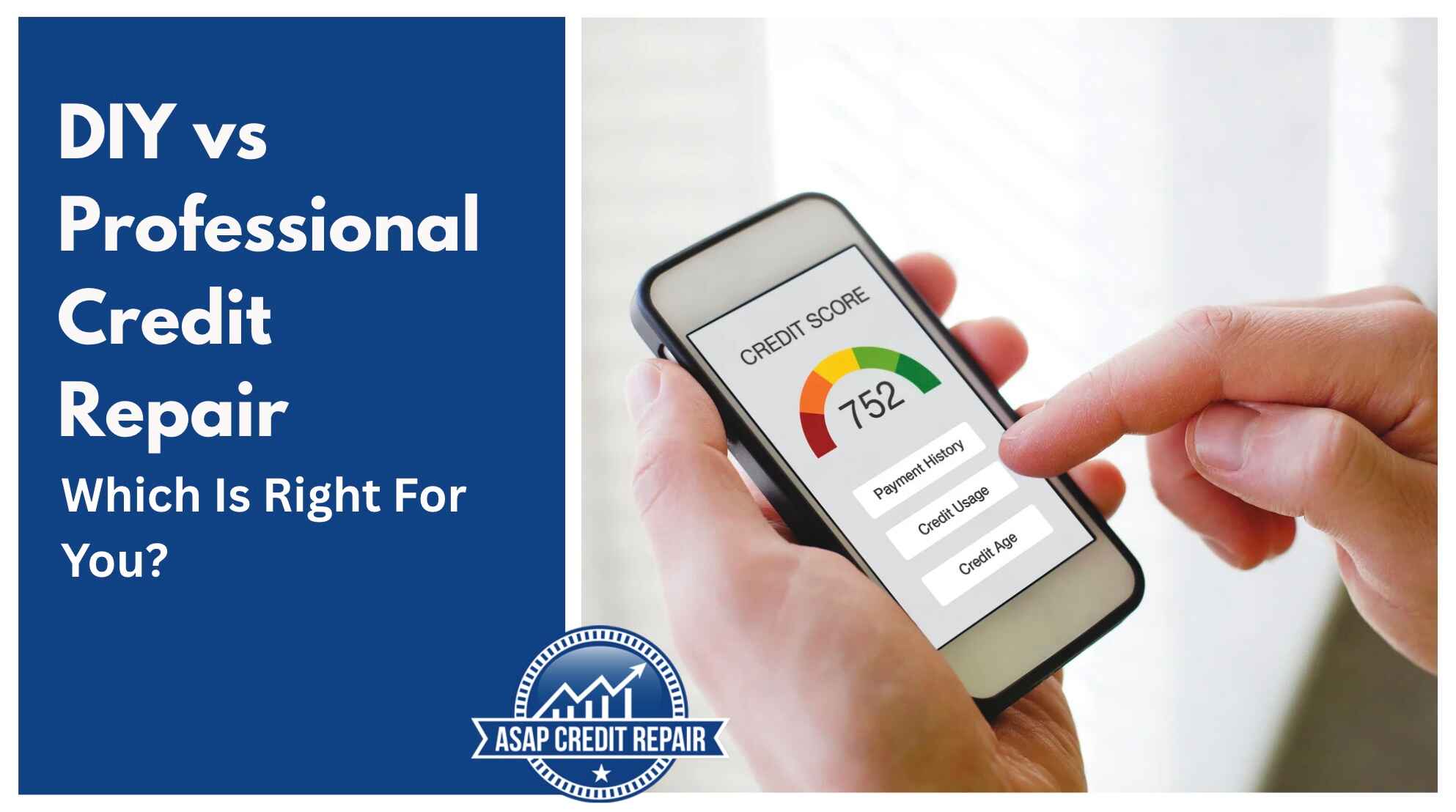DIY vs Professional Credit Repair: Which Is Right For You?

by Joe Mahlow • Updated on Nov. 01, 2025

DIY vs Professional Credit Repair: Which Is Right For You?
DIY credit repair versus professional services remains one of the most frequently asked questions in personal finance forums, consumer advocacy websites, and financial planning discussions. If you're struggling with negative items on your credit report and wondering whether to tackle the problem yourself or hire experts, understanding the differences between these approaches can save you time, money, and frustration.
What DIY Credit Repair Actually Involves
Do-it-yourself credit repair means personally handling every aspect of disputing inaccurate, unfair, or unverified items on your credit reports. This includes obtaining credit reports from all three bureaus, identifying errors or questionable information, drafting dispute letters, tracking responses, following up with bureaus and furnishers, and maintaining detailed records throughout the process.
The DIY approach requires significant time investment. You'll spend hours reviewing credit reports line by line, researching consumer protection laws like the Fair Credit Reporting Act, understanding dispute procedures, and corresponding with multiple parties. For someone comfortable with paperwork, organization, and persistent follow-through, DIY credit repair can be effective.
Your responsibilities include pulling reports from Equifax, Experian, and TransUnion, documenting every inaccuracy with supporting evidence, writing professional dispute letters that cite specific laws and regulations, mailing letters via certified mail to track delivery, waiting 30-45 days per dispute round, reviewing bureau responses carefully, and deciding on next steps based on outcomes.
Monthly Time Investment Comparison
The True Cost of Doing It Yourself
While DIY credit repair eliminates monthly service fees, it's not entirely free. You'll pay for credit report monitoring services to track changes across all three bureaus, typically costing fifteen to thirty dollars monthly. Certified mail expenses add up quickly when sending multiple dispute letters to three bureaus and various furnishers, averaging three to five dollars per letter.
Time represents your biggest investment. Most people spend ten to fifteen hours monthly on DIY credit repair activities during active dispute periods. If you value your time at even twenty dollars per hour, those ten hours equal two hundred dollars in opportunity cost monthly. Over a six-month credit repair campaign, you might invest sixty hours of personal time.
Additional costs include printing supplies, postage, and potentially purchasing dispute letter templates or credit repair guides. Some people also subscribe to legal self-help resources to ensure they're following proper procedures. These expenses can total fifty to one hundred dollars over several months.
6-Month Cost Comparison
Understanding Professional Credit Repair Services
Professional credit repair companies employ trained specialists who understand credit bureau systems, furnisher response patterns, and effective dispute strategies. These companies handle the entire process on your behalf, from pulling initial reports to negotiating with creditors and bureaus.
Reputable credit repair services typically operate on monthly subscription models or pay-for-performance structures. Monthly services range from fifty to one hundred fifty dollars depending on service level and features included. Pay-for-performance companies charge fees only for successfully removed items, typically twenty-five to one hundred fifty dollars per deletion.
Professional services provide expertise that most consumers lack. Credit specialists understand which dispute methods work best for different negative item types, how to escalate disputes effectively, when to involve attorneys, and how to navigate complex situations like identity theft or mixed credit files.
What Professional Services Cannot Do
It's crucial to understand the legal limitations of credit repair companies. No service can legally remove accurate negative information from your credit reports, regardless of marketing claims. Legitimate companies won't promise specific score increases or guarantee particular results since every credit situation differs.
Professional credit repair focuses on disputing inaccurate, unfair, or unverifiable information. If an account is accurately reported and properly verified, it must remain on your report until the legal reporting period expires—typically seven years for most negative items and ten years for bankruptcies.
Beware of companies promising to create new credit identities, hiding bad credit by obtaining an Employer Identification Number, or removing accurate bankruptcies immediately. These practices are illegal and can result in serious legal consequences for consumers who participate.
| Feature | DIY Credit Repair | Professional Services |
|---|---|---|
| Monthly Cost | $25-50 (supplies + monitoring) | $50-150 |
| Time Commitment | 10-15 hours/month | 0-1 hour/month |
| Expertise Required | High (self-learning) | None (handled by experts) |
| Success Rate | Varies (depends on skill) | Higher (experienced teams) |
| Best For | 1-3 simple errors | 5+ complex items |
| Timeline | 6-12 months | 3-9 months |
When DIY Credit Repair Makes Sense
Do-it-yourself credit repair works best in specific situations. If you have just one or two obvious errors on your reports—like accounts that don't belong to you, duplicate entries, or incorrect payment histories—DIY disputes can resolve these quickly without professional help.
DIY is ideal when you have ample free time to dedicate to the process. If you're between jobs, working part-time, or have flexible scheduling, investing ten to fifteen hours monthly becomes more feasible. The learning curve is manageable for people comfortable with bureaucratic processes.
Financial constraints make DIY attractive. If your budget cannot accommodate fifty to one hundred fifty dollars monthly for professional services, handling disputes yourself remains your viable option. Many consumers successfully repair credit on tight budgets through persistent DIY efforts.
Simple credit situations favor DIY approaches. If your credit issues stem from a specific event—like identity theft with a police report, accounts opened fraudulently, or a clear creditor error—documentation is straightforward and disputes typically succeed without professional intervention.
Success Rates by Complexity Level
When Professional Services Provide Better Value
Complex credit situations justify professional help. If you have multiple negative items across different categories—collections, charge-offs, late payments, judgments, tax liens—coordinating simultaneous disputes across three bureaus becomes overwhelming. Professionals manage this complexity efficiently.
Time-sensitive goals require professional expertise. When you're preparing to apply for a mortgage within six months or need improved credit for a business loan, professional services accelerate the process through experience and established relationships with bureaus and furnishers.
High-stakes financial situations warrant professional assistance. If poor credit is costing you thousands annually in higher interest rates or preventing you from purchasing a home, investing one thousand to two thousand dollars in professional credit repair delivers significant return on investment.
Legal complications necessitate professional or attorney-backed services. Cases involving identity theft requiring police reports and affidavits, mixed credit files combining your information with someone else's, or furnishers consistently refusing to correct obvious errors benefit from legal expertise.
The Hybrid Approach: Combining Both Strategies
Many consumers achieve success through hybrid strategies that blend DIY efforts with professional services. You might start with DIY for obvious errors and simple disputes, then hire professionals for remaining complex items that resist initial dispute attempts.
Another hybrid approach involves hiring professionals for the initial aggressive dispute rounds when multiple items need addressing, then transitioning to DIY maintenance once your credit improves. This maximizes professional expertise during critical periods while reducing long-term costs.
Some people use professional services for specific problem accounts while handling routine disputes themselves. For example, you might pay professionals to tackle a stubborn collection agency while personally disputing late payment errors with credit card issuers.
Evaluating Your Personal Situation
Assess your credit report complexity by obtaining reports from all three bureaus and counting negative items. Five or fewer items might be manageable DIY, while ten or more suggest professional help could provide better results. Consider item types—collections and charge-offs are more complex than simple late payment disputes.
Evaluate your available time realistically. Can you dedicate ten hours monthly for six months without sacrificing work, family, or health? If your schedule is already overwhelming, professional services provide peace of mind and consistent progress without additional stress.
Consider your comfort level with bureaucratic processes, formal letter writing, and persistent follow-up. DIY credit repair demands attention to detail, organization, and emotional resilience when facing rejection or slow progress. If these traits don't describe you, professionals handle these challenges.
Calculate your break-even point. If poor credit costs you two hundred dollars monthly in higher interest rates, spending one hundred dollars monthly on professional credit repair delivers net savings while accelerating improvement. Compare these numbers for your specific situation.
Making Your Final Decision
Neither DIY nor professional credit repair is inherently superior—the right choice depends entirely on your unique circumstances, resources, and goals. DIY works excellently for motivated individuals with time, patience, and straightforward credit issues. Professional services deliver value for complex situations, time-sensitive goals, or people lacking time or confidence for DIY approaches.
The most important factor is taking action. Whether you choose DIY, professional services, or a hybrid approach, starting the credit repair process is far more important than which method you select. Delaying action costs you financially through higher interest rates and limits your opportunities for mortgages, auto loans, and other credit-dependent goals.
Research thoroughly before selecting professional services. Check Better Business Bureau ratings, read recent customer reviews, verify proper licensing and bonding, and ask detailed questions about processes, timelines, and fees. Legitimate companies welcome scrutiny and provide transparent answers.
If starting with DIY, commit fully to the process. Set aside dedicated time weekly, create organized filing systems for tracking correspondence, learn relevant consumer protection laws, and maintain persistence despite slow progress or setbacks. Half-hearted DIY efforts waste time without producing results.
Remember that credit repair—whether DIY or professional—requires patience. Significant improvements typically take three to nine months regardless of approach. Setting realistic expectations prevents frustration and helps maintain focus on long-term credit health rather than quick fixes that don't exist.